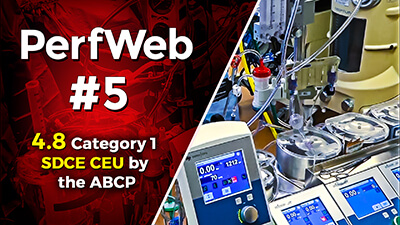Learn how to read the basic chest X-Ray, CT Scans, and Trans – Esophageal Echo. A description of a systematic method for examining a chest X-ray and a review of the relevant thoracic anatomy
Register @ library.perfusioneducation.com
Faculty: Lucas Duvall, MD
Patrick O’Toole, CPP Perfusionist
Joseph Basha, CPP Perfusionist
0:00—Open – Joe Basha, CPP
6:30—What is X-Ray. Pros of X-ray
7:00—What you can see when you look at x-ray (how to read x-ray) steps: Make sure is the right patient Make sure is correct date of the study Look at the bony structures (clavicles, ribs, spine) Make sure patient do not have clavicle fracture. Look at the soft tissue structures (heart, trachea, bronchial, Diaphragm, stomach, soft tissue in the neck)
9:56—Looking at the soft tissues
10:00—What are looking at (x – ray) pericardium has been open, etc.
#1 Artery coming down to
#2 Superior vena cava
#3 Arch of the aorta
#4 Left lateral border of the heart
#6 Pulmonary arteries of the veins
#7 Around the left ventricular
#8 moving down to subsegmental pulmonary artery veins
#9 Right border of the heart
#10 lung field
#11 Inferior vena cava as well diaphragm
#12 Reflection of pericardium to diaphragm and to gastric region
11:44—Particular X-ray has few different things to look at: Intubated patient
11:53—Trachea tube
12:00—EKG leads
12:18—Patient with significant pneumonia or ARDS (Acute Respiratory Distress Syndrome)
15:30—X-Ray white spots indicates some sort of pathology
16:58—Classic x ray funding subsegmental pulmonary embolism
17:22—Lungs full of fluid
18:23—Bone structures normal, identify trachea, Diaphragm
19:27—Large hernia defect
19:38—Air bobble in the stomach (chest pain)
20:42—Lungs problems (x-ray)
21:48—Massive pulmonary embolism
23:22—Representation of ARDS
24:15—Vascular congestion
24:44—Vascular congestion vs ARDS (Acute Respiratory Distress Syndrome), Cephalization of Vessels
25:10—Pulmonary Edima
38:54—Localization of Swan – Ganz Catheter (chest radiograph)
49:38—Diagram where balloon pump to be (systole, diastole) Faculty: Lucas Duvall, MD
1:29:40—Trans Esophageal Echo (TEE)
1:30:00—Echo tutorial: Echocardiogram probe placement (Echocardiography for Medical Students)
1:33:43—Looking to the mitral valve
1:54:40—P1 vs P2
1:56:00—Mid esophageal two chamber view (mitral valve)
2:01:17—Validating the quality of bypass graft
2:01:44—Perfusing brain
2:02:12—Mid esophageal mitral commissural
2:04:50—Midesophageal Aortic valve short access view (SAX)
2:07:15—Mid esophageal Aortic valve long access view (LAX)
2:12:43—Mid esophageal Bicaval
2:15:22—Tricuspid valve
2:19:30—Perfect view for positioning cannulas
2:20:00—Transgastric two chamber
2:21:37—Massive LV thrombus (Parasternal long access view shows a large mass coming into and out of the plane of the video. there is also significant wall motion abnormality noted in the inferolateral wall and anteroseptum)
2:26:18—Mitral/tricuspid endocarditis (Trans Esophageal Echo view shows a large vegetation adherent as well as large vegetation along mitral valve)
2:26:40—Doppler views of the tricuspid valve show more then one leaflet is involved and that there is severe tricuspid regurgitation by color Doppler. Closer look at the mitral valve shows the posterior leaflet is primarlly involved with resultant eccentric regurgitation over the anterior leaflet. The aortic valve was a free of disease. This individual went on to have mitral and tricuspid valve surgery.
2:39:54—Mechanical assist devices, pacemakers – transesophageal echocardiography improves image quality in many ways over transthoracic echo.
2:40:34—The descending aorta and distal arch can be seen in SAX at 0 degrees by rotating torward the aorta from the mid esophageal position and slowly withdrawing a probe. In newer TEE systems with 3D capabilities, x plain is often used to view the aorta in both short axis (left) and long axis (right) to ensure that dissection and atheroscleortic plaque are not missed.
2:42:46—Deep transgastric view, 0 degrees, 2D view (the deep transgastric view is similar to the apical 5 chamber view obtain in transthoracic imaging. Wave cursor can be oriented essentially parallel to the aortic valve from this view to allow accurate measurement of gradients across the aortic valve to assess degree of AS/AR. Deep transgastric views are the best TEE views assessing aortic stenosis and regurgitation, because in general the TEE probe can be oriented parallel to the direction LVOT and aortic valve. The deep transgastric views are obtained by advancing TEE probe deep in to stomach and gentle anteflexing.
2:53:21—TEE removing air from LV S/P CABG
3:17:05—CT Scan thyroid gland (esophagus, SVC) size of the CT scan cuts
3:18:12—CT Scan of the liver, spleen, kidney, pancreas
3:18:36—Different types of views CT Scan
3:21:50—CT scan of aorta view (angiogram)
3:41:49—CT scan of aortic aneurysm
Faculty: Lucas Duvall, MD Patrick O’Toole, CPP Perfusionist Joseph Basha, CPP Perfusionist

